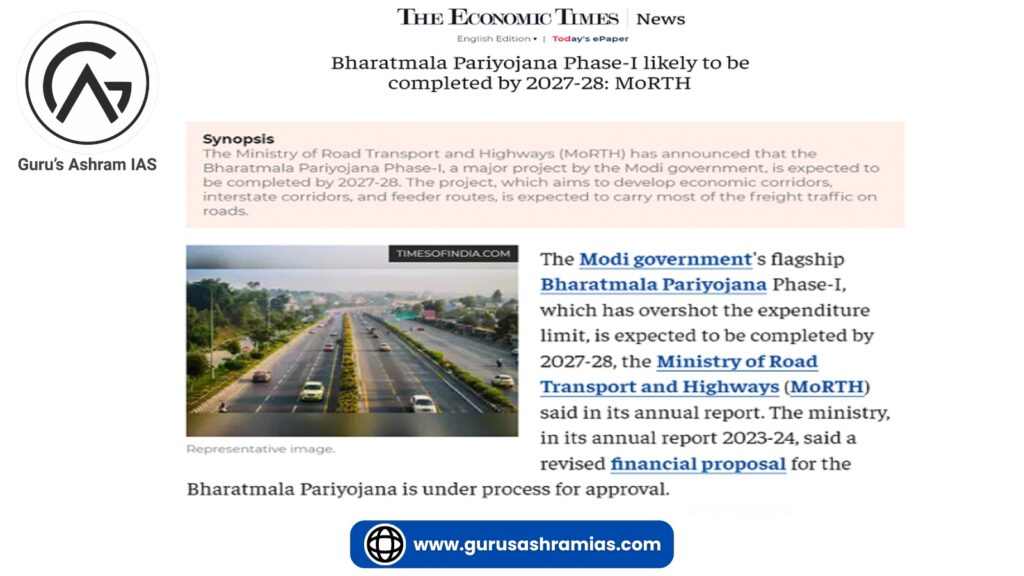Bharatmala Pariyojana
- About 50% work of Bharatmala Pariyojana Phase-I, a major road network expansion programme, has been completed by 31st March 2024 and is expected to be completed by the year 2027-28.
- The Vision 2047 of the Ministry of Road Transport and Highways aims to provide high-speed corridors within 100-150 km to all citizens and enhance passenger convenience by developing world-class facilities.
- This approach is the basis of the master plan for highways and related infrastructure in India.
Bharatmala Pariyojana:
- Bharatmala Pariyojana is a comprehensive programme launched under the Ministry of Road Transport and Highways.
- The first phase of Bharatmala was announced in 2017 and was to be completed by 2022 but could not be completed due to slow implementation and financial constraints.
- Bharatmala, Sagarmala, dry / land ports and other infrastructure projects have been included under PM Gati Shakti Yojana to enhance connectivity and logistics efficiency.
- While the Bharatmala Pariyojana is aimed at improving road connectivity by increasing cargo and passenger traffic, the Sagarmala Pariyojana is aimed at modernising ports and promoting coastal shipping to boost trade and maritime activity.
Main features:
Economic Corridors and Improving their Efficiency:
- Bharatmala focuses on enhanced effectiveness of already built infrastructure, multimodal integration, addressing infrastructure gaps for seamless movement and integrating national and economic corridors.
- It aims to build about 26,000 km of economic corridors, including the Golden Quadrilateral (GQ) and North-South and East-West (NS-EW) corridors, to carry most of the freight traffic on highways.
Inter-corridor and feeder route:
- It will ensure connectivity from the first mile to the last mile.
- About 8,000 km of inter-corridor and about 7,500 km of feeder routes have been identified to improve the effectiveness of these corridors.
Border and International Connectivity Roads:
- Better border road infrastructure will ensure greater mobility and also boost trade with neighbouring countries.
Roads for coastal and port connectivity:
- Connectivity in coastal areas promotes port-led economic development, leading to both tourism and industrial development.
Green-field expressways:
- Expressways with high traffic density and presence of more jammed space will benefit from green-field expressways.
Financing Mechanism:
- Bharatmala Pariyojana is being funded from various sources including Central Road and Infrastructure Fund cess, remittances, extra budgetary support, monetization of National Highways, internal and extra budgetary resources and private sector investment.
Status:
- Till March 2024, Bharatmala Pariyojana Phase-I has successfully awarded contracts for construction of 26,425 km of roads and completed 17,411 km with a total outlay of Rs. 4.59 lakh crore.
- The project covers an area of 34,800 km in 31 States and Union Territories and over 550 districts.
Other similar initiatives for road infrastructure development:
Pradhan Mantri Gram Sadak Yojana (PMGSY):
- The project was launched in 2001 with the goal of connecting unconnected habitations.
- The National Infrastructure Pipeline (NIP)
- The National Infrastructure Pipeline (NIP) is an initiative that will provide world-class infrastructure across India to improve the overall quality of life of all citizens and attract domestic and foreign direct investment.
- Infrastructure projects include social and economic infrastructure projects in sectors such as energy, roads, urban and railways, which account for about 70% of the estimated capital expenditure in infrastructure in India.
- This includes greenfield and brownfield projects worth more than Rs 100 crore.
Golden Quadrilateral Project:
- It is a network of 4-6 lane highways connecting 4 top metropolitan cities of India i.e. Delhi, Mumbai, Chennai and Kolkata, forming a quadrilateral.
- The project was started in the year 2001 as part of National Highways Development Project (NHDP). It is the largest highway project in India.
The Golden Quadrilateral has four sides:
- Delhi-Kolkata: 1,453 km
- Chennai-Mumbai: 1,290 km
- Kolkata-Chennai: 1,684 km
- Mumbai-Delhi: 1,419 km
New Contract Models and Asset Monetization:
- In addition to traditional tendering methods such as Engineering, Procurement and Construction (EPC) and Build, Operate, Transfer (BOT), many new contract models have emerged.
- These include Hybrid Annuity Model (HAM), Toll, Operate and Transfer (TOT) and Infrastructure Investment Trust (InvIT).
Importance of Road Infrastructure in India’s Development:
Economic growth and productivity:
- Road networks are critical to India’s economic growth, contributing more than 3.6% to GDP and carrying more than 85% of passenger traffic and 65% of freight.
- They reduce transportation costs, increase market access and encourage trade.
- They also create significant employment opportunities while supporting local economies and helping to reduce poverty.
Rural Development and Social Equality:
- Under schemes like PMGSY, rural roads reduce the distance between remote areas and essential services.
- They empower marginalized communities, reduce isolation and enhance the quality of life in rural areas.
- Improved road connectivity enhances access to essential services such as education and healthcare.
Tourism and cultural exchanges:
- Efficient road networks facilitate tourism, which contributes significantly to the economy. Sightseeing routes and access to heritage sites promote cultural exchange and support local economies.
National Security and Defence:
- Roads are vital for defence logistics and emergency responses. Border and strategic roads are essential for national security and military traffic.
Major concerns related to road infrastructure development:
Concerns about the environment:
- Road construction raises environmental concerns such as deforestation, loss of biodiversity and increased pollution. It is a major contributor to habitat fragmentation, air and noise pollution and climate change, highlighting the need for sustainable infrastructure practices.
- The International Energy Agency (IEA) reports that road transport accounts for 12% of India’s CO2 emissions, with heavy vehicles being the primary contributor to particulate matter (PM) 2.5 emissions.
The social concerns:
- Road projects can lead to displacement of communities, especially in rural areas leading to safety issues. Inadequate rehabilitation can exacerbate poverty, while poorly designed roads contribute to accident rates. More than 1,50,000 deaths were reported in India in 2021, underscoring the need for safe infrastructure.
The economic concerns:
- Many road projects have extreme cost overruns and delays, with the Comptroller and Auditor General (CAG) reporting instances in which costs were found to be more than 40% over budget.
- Additionally, lack of a robust maintenance framework leads to rapid deterioration of roads, which almost doubles the long-term cost.
Governance and Policy Issues:
- This includes corruption in auctioning and implementation, leading to creation of substandard infrastructure.
- Additionally, the lack of comprehensive planning leads to poorly executed projects, highlighting the need for integrated transport planning.
Solution:
- There is a need to focus on strategic procurement to get raw materials at competitive rates and bargain with suppliers on favourable terms. Also, it is necessary to streamline land acquisition by adopting transparent practices and explore options like land pooling to reduce disputes. In addition, there is a need for stable GST policies and to work closely with government authorities to address the impact of tax changes on the industry.




